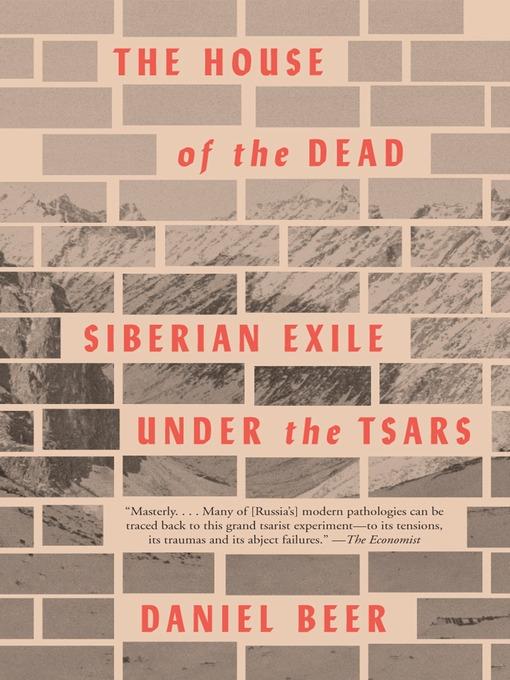
The House of the Dead
Siberian Exile Under the Tsars
کتاب های مرتبط
- اطلاعات
- نقد و بررسی
- دیدگاه کاربران
نقد و بررسی

October 17, 2016
In this meticulously researched and often enlightening account, Beer (Renovating Russia), senior lecturer in history at Royal Holloway, University of London, shows that populating and cultivating the resource-rich expanse east of the Ural Mountains was a test that the czars failed spectacularly. As early as the 17th century, Russian peasants, soldiers, and officials began to settle Siberia, soon joined by exiles “in ever greater numbers.” Throughout the 18th and 19th centuries, the state banished people deemed “harmful agents” to serve prison sentences, perform hard labor, or settle permanently in what became Russia’s “Wild East.” Thrown together in grueling convoys, deteriorating way stations, and hellish mines were minor offenders, hardened criminals, and generations of revolutionaries for whom Siberia was both a punishment and a chance to test and spread revolutionary ideas. Beer details the systemic incompetence of the penal administration and the brutal physical punishments inflicted on exiles, as well as the violence that escaped convicts unleashed on the indigenous population. Loosely organized and often repetitive, Beer’s history is nevertheless dense with memorable anecdotes and images, including a hillside of empty graves dug to serve a penal colony. As Beer demonstrates, the Russian empire’s grand ambitions for Siberia, like those graves, “sank into the earth without a trace.” Illus. Agent: Michael V. Carlisle, InkWell.

Starred review from October 1, 2016
An elucidating study of how Russias east was wonby hard labor.Since the 16th century, Siberia has served as Russias repository for undesirables, much as the New World and Australia served for Britain. In this engaging study of Russias far-flung penal system, British academic Beer (History/Royal Holloway, Univ. of London; Renovating Russia: The Human Sciences and the Fate of Liberal Modernity, 1880-1930, 2008) reveals how the vast area east of the Ural Mountains was gradually settled by fur trappers, soldiers, fugitive serfs, mercenaries, and exiles, pacifying nomadic tribes already sparsely inhabiting the taiga to the north and the steppe to the south. Imperial banishment to Siberia for criminality served both to purge European Russia of mutinous populations and to populate the vast eastern expanse and harvest raw materials at key labor sites like the mines of Nerchinsk. Exile was severe and final, especially in the early centuries, with the victim given a civil death by a public ceremonial breaking of the sword over his head, flogging, facial scarring, and shaving of one side of the skull; malefactors were fettered together and marched over thousands of miles on primitive roads and many miserable months to reach labor camps. Wives and children were encouraged to accompany the men, although little did the women know of the harsh and dangerous conditions that awaited them (return was barred to them as well). Beer concentrates on political exiles, specifically the Decembrists, who, inspired by ideals of national liberalism, attempted to overthrow Czar Nicholas I in 1825. Many of them were educated aristocrats who used exile for fomenting republicanism, becoming martyrs to the causes of freedom and reform. Beer ably shows how these educated dissidentsincluding Fyodor Dostoevsky, whose House of the Dead lends its title to this worktransformed Siberia from a political wasteland into a crucible of the nascent Russian revolutionary movement. An eye-opening, haunting work that delineates how a vast imperial penal system crumbled from its rotten core.
COPYRIGHT(2016) Kirkus Reviews, ALL RIGHTS RESERVED.

October 15, 2016
Tsars of the 19th century, from Alexander I to Nicholas II, used Siberia as a penal colony, believing hard labor would transform convicts into motivated settlers who would pioneer the Westernization of the Russian East. Beer (history, Univ. of London; Renovating Russia: The Human Sciences and the Fate of Liberal Modernity, 1880-1930) relates in harrowing detail the misery of 19th-century exile to Siberia. The harsh climate, primitive living conditions, and physical punishments inflicted on convicts (living in fetters, flogging, knouting, gauntlets, and starvation) turned humans feral or broken. Rather than becoming productive workers when released from slave labor to live in the frontier, criminal exiles terrorized peasants and towns. Political exiles, like the Decembrists, returned to western Russia even more radicalized. By the end of the 1800s, Siberian exile was a rite of passage for the revolutionaries who overthrew Nicholas II. VERDICT Readers with an interest in Russian history and the prehistory of the Soviet gulag will appreciate Beer's effective use of 19th-century journalism, Russian novels, and official reports to evoke the hopelessness of Siberian exile and the utter failure of the region as a prison without walls. [See Prepub Alert, 7/25/16.]--Laurie Unger Skinner, Coll. of Lake Cty., Waukegan, IL
Copyright 2016 Library Journal, LLC Used with permission.

December 15, 2016
For nineteenth- and twentieth-century European liberals, the term, Siberian exile, conjured up the worst perceived aspects of Russian autocracy, including arbitrary imprisonment, torture, beatings, and horrible living conditions. It was, as Dostoevsky termed it, truly life in a house of the dead. But British historian Beer shows that the reality was more complex. Brutality certainly existed, with punishment inflicted with the dreaded knout (a knotted whip). Yet, unlike Stalin's gulag, both Western and Russian writers frequently observed the Siberian prisons and were often surprised by the familiarity between guards and prisoners. Some guards, properly bribed, could be induced to perform onerous tasks in place of some prisoners, such as working in mines. Prison populations could be an eclectic mixture, including outspoken liberals, Polish nationalists, and, eventually, violent Marxist rebels. Wives and other family members sometimes joined the convicted in voluntary exile, and the cleverest prisoners could sometimes maintain a relatively comfortable existence. This is a well-researched and interesting effort to examine a lifestyle' that now appears small-scale and almost benign compared to the approaching horrors of Stalinist repression.(Reprinted with permission of Booklist, copyright 2016, American Library Association.)

























دیدگاه کاربران